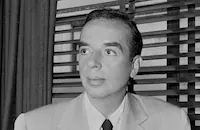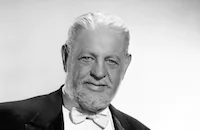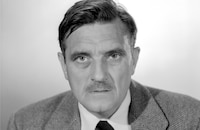I Dood It

Brief Synopsis
Cast & Crew
Vincente Minnelli
Red Skelton
Eleanor Powell
Richard Ainley
Patricia Dane
Sam Levene
Film Details
Technical Specs

Synopsis
Bumbling hotel pants-presser Joseph Rivington Renolds is obsessed with Broadway performer Constance Shaw and routinely "borrows" his customers' fancy clothes in order to follow her around town. The temperamental Connie, however, is oblivious to Joe, preferring the company of her fiancé, actor Larry West. One night, while Joe is at a nightclub wearing a customer's expensive tuxedo, Connie comes in and sees Larry kissing socialite Suretta Brenton. Enraged with jealousy, Connie sits at Joe's table and pretends to be his date. By chance, the tuxedo's owner, tourist Spelvin, is sitting at the next table and recognizes his suit on Joe. Spelvin pursues him onto the dance floor, but is unable to catch the clumsy Joe, who flees the club. Later, Joe goes to see his sixty-fifth performance of Dixie Lou , a Civil War melodrama starring Connie and Larry. After the show, Kenneth Lawlor, the producer of Dixie Lou , brings Suretta to Connie's dressing room to discuss backing for Connie and Larry's next show. After the smug Suretta shows off a ruby bracelet that the ambitious Larry has bought for her, Connie is furious and storms out of her dressing room. On her way out, she runs into Joe and, seeing the smitten fan, gets an idea. Sometime later, Connie and Joe return to the nightclub, and seeing Larry, Suretta and Kenneth seated together, Connie introduces Joe as her new husband. Connie, who has misheard Joe and thinks that he owns gold mines, informs Kenneth about her husband's wealth, and Kenneth immediately sets up a meeting with him. Connie and Joe then check into the honeymoon suite at the same hotel at which Joe works, and while Joe is out securing some champagne, Connie starts to write a farewell letter to him. Before she finishes, however, Larry calls and again infuriates her with his indifference. Connie is about to sneak off when Joe returns with the champagne. Unable to say goodbye to the lovestruck Joe, Connie decides to drug him instead and slips some of her sleeping pills into his champagne. Joe unwittingly switches the glasses, however, and Connie falls into a deep slumber. The next morning, Kenneth arrives at the suite with Larry and Suretta, who claims to want to invest in Kenneth's new show with Joe. Unknown to Kenneth, Joe and Connie, Suretta is aware of Joe's impersonation and has called for valet service. When Joe's boss, tailor Ed Jackson, shows up and sees Joe in the room, he angrily exposes him as a pants presser, and Connie immediately agrees to a divorce. Feeling that he has nothing more to lose, Joe slugs the cocky Larry, then attempts suicide by asphixiating himself with the valet service gas. As the gas is soon turned off, Joe only falls asleep and is eventually awakened by Ed. The blustery Ed at first criticizes Joe for thinking he could marry a famous performer like Connie, then changes his mind and insists that Joe demand his conjugal rights. Pushed by Ed, Joe sneaks into the theater through the cellar and bumps into actor Roy Hartwood. Unknown to Joe, Roy is a Nazi saboteur and has been digging a hole in the theater wall so that he can plant a bomb and destroy some ordnance that are being stored next door. When Roy is later ordered by his superiors to set off the bomb that night, he asks Joe, who has bragged that he knows every line in the show backward and forward, to go on for him. Joe reluctantly agrees and dons Roy's stage beard and costume. Mistaking Joe for Roy, one of Roy's Nazi cohorts slips him a message about a submarine rendezvous, but Joe fails to grasp its significance. Although Joe's amateurish, bumbling performance enrages Connie, Joe refuses to leave the stage. When he suddenly understands the Nazi's message, however, Joe dashes offstage and becomes engaged in a protracted fight with Roy. After knocking out Roy, Joe races to the cellar and begins a frantic search for the bomb. Connie soon joins him and, impressed by his bravery, professes her love. Moments before it is to explode, Joe defuses the bomb and then learns from the police that he will be rewarded for his efforts. Later, Joe becomes not only Connie's true husband but the co-producer of her next show as well.

Director

Vincente Minnelli
Cast

Red Skelton

Eleanor Powell

Richard Ainley

Patricia Dane

Sam Levene

Thurston Hall

Lena Horne
Hazel Scott

John Hodiak

Butterfly Mcqueen

Marjorie Gateson
Andrew Tombes
Jimmy Dorsey
Helen O'connell
Bob Eberly

Morris Ankrum

Charles Judels
Tommy Dorsey
Buck And Bubbles
Clinton Rosemond

Joe Yule

Juanita Quigley
Spec O'donnell
Harry Depp
Anne O'neal
Jack Daley
Jessie Tai Sing
Russ Clark
Leon Tyler
Rafael Storm
Ruby Dandridge
Gino Corrado
Myron Healey
Art Belasco
Mark Daniels
Jack Lipson
Mitchell Lewis
Ernie Alexander
Chester Clute

Dorothy Morris
Lionel Braham
Margaret Seddon
Margaret Mcwade
Sven-hugo Borg
Jack Carrington

Merrill Mccormick
Hans Von Morhart
Cecil Stewart
Larry Daniels

James Flavin
William Bishop
James Farley
Crew
Count Basie
Bobby Connolly
Helen Conway
Jack Cummings
Jack Dawn
Vernon Duke
William Ferrari
Ted Fetter
Cedric Gibbons
Sig Herzig
Irene
Ray June
Buster Keaton
Robert J. Kern
Gilbert Kurland
John Latouche
Bert Lynch
Richard Myers
Ray Noble
Gene De Paul
Cole Porter
Merrill Pye
Don Raye
Leo Robin
Charles Rosher
Fred Saidy
Sharaff
Douglas Shearer
Al Shenberg
Jack Martin Smith
Gile Steele
Georgie Stoll
Kay Thompson
Edwin B. Willis

Photo Collections
Film Details
Technical Specs

Articles
I Dood It
Minnelli also said, "Some footage had to be maintained, I was instructed. There were two irrelevant musical numbers shot previously, one of them an Eleanor Powell production number on a battleship and the other an exercise in twirling ropes. We all did the best we could, and managed to do a creditable job. If nothing else, the picture taught me that I could function in an uninteresting exercise if I had to."
I Dood It was conceived as a loose remake of Buster Keaton's last silent film, Spite Marriage (1929). Skelton lifted many of Keaton's gags blow-by-blow in the story of a tailor's assistant who adores the young stage star (Powell) of a Civil War melodrama. He attends all her performances and tries to impress her. She marries him, but it's clear this is only to spite her boyfriend, who has taken up with another woman. In a plot device that reveals the film's WWII era, Skelton then foils a saboteur plot, which really does impress Powell - and it's not too hard to guess the ending that follows. The thin plot isn't much, existing merely to showcase the talents of Skelton and Powell, as well as performers Lena Horne ("Jericho"), Hazel Scott ("Taking a Chance on Love") and Jimmy Dorsey ("One O'Clock Jump"). Several of Eleanor Powell's dance routines are stolen from her earlier movies - most notably in the film's climax, which is lifted almost step-for-step from Born to Dance (1936). Minnelli was unable to reshoot these scenes and as such they are not representative of his talents.
Not surprisingly, the best thing about I Dood It is a musical sequence that Minnelli did come up with himself, three months after principal production wrapped. Poor test screenings prompted Minnelli to devise a battle of songs between Lena Horne and Hazel Scott, playing themselves against an all-black chorus. As was common in this era for musical numbers featuring black performers, it was designed to have so little to do with the plot that it could easily be excised by southern theater owners.
This was Eleanor Powell's last film for MGM. Soon afterwards, she married Glenn Ford and virtually retired from the screen, except for a part in United Artists' Sensations of 1945 (1944), some sporadic cameo appearances, and a television show. The phrase "I dood it" came from Red Skelton's popular radio comedy act.
Producer: Jack Cummings
Director: Vincente Minnelli
Screenplay: Sig Herzig, Fred Saidy
Cinematography: Ray June
Film Editing: Robert J. Kern
Art Direction: Cedric Gibbons
Music: Ted Fetter
Cast: Red Skelton (Joseph Renolds), Eleanor Powell (Constance Shaw), Richard Ainley (Larry West), Patricia Dane (Suretta Brenton), Sam Levene (Ed Jackson), Thurston Hall (Kenneth Cawlor).
BW-103m. Closed captioning.
by Jeremy Arnold

I Dood It
Quotes
Trivia
Footage for the number "Swinging the Junx Away" was borrowed from Born to Dance (1936).
'Eleanor Powell' reportedly knocked herself out cold during rehearsals for the lariat dance.
Notes
"I dood it" was comedian Red Skelton's radio "catch phrase." In addition to the above-listed numbers, instrumental excerpts from the following songs were also heard in the film: "Petunia" by Lew Brown, Sammy Fain and Ralph Freed, accompanied by a black chorus; "Shorter Than Me" by Gene de Paul; "Lord and Lady Gate" by Don Raye and Gene de Paul; "Contrast" by Jimmy Dorsey; and "Anchors Aweigh" by Charles A. Zimmerman. Two of Eleanor Powell's dance numbers consisted of footage taken from earlier pictures. The "Hola E Pae" number, which featured Powell performing a combination of tap and hula dancing, was first seen in the 1939 M-G-M film Honolulu as part of a Hawaiian medley. "Swingin' the Jinx Away" was first seen in M-G-M's 1936 musical Born to Dance, which was directed by Roy Del Ruth and starred Powell and Jimmy Stewart. (See AFI Catalog of Feature Films, 1931-40; F3.1979 and F3.0441).
Hollywood Reporter news items add Sam Garrett, Otto Reichow, Hank Mann and Constance Weiler to the cast, but their appearance in the completed film has not been confirmed. (Garrett is credited in modern sources as Powell's roping instructor.) News items also list the following dancers as cast members: Mitzie Vehlein, Judi Blacque, Sheila Rae, Dona Massin, Jane Ray, Jean Ashton, Beth Renner, Eleanor Bayley, Joyce Murray, Marilyn Kinsley, Wanda Stevenson, Vera Lee, Jetsy Parker and Marilyn Christine. The appearance of these performers in the final film has not been confirmed, however. Although Hollywood Reporter announced that nine-year-old jitterbug experts Marilyn Kay and Vicki Humphreys had been cast, no jitterbug scenes were included in the final film. Modern sources indicate that the planned jitterbug scene, which Powell especially wanted to film, was replaced by the hula number.
According to modern sources, when M-G-M was unable to find young male dancers who could work a lariat for the "So Long, Sarah Jane" number, Powell hired real, older cowboys. In his autobiography, director Vincente Minnelli recalled that the "So Long, Sarah Jane" number was shot previous to his involvement in the production. Hollywood Reporter news items indicate that while rehearsals for the dance began as early as July 1942, under the direction of choreographer Bobby Connolly, the number was filmed during principal photography. Modern sources note that Minnelli, whose previous film, Cabin in the Sky , featured an all-black cast, suggested adding Lena Horne and Hazel Scott to the picture. According to news items, their numbers were, in fact, shot after principal photography.
I Dood It was a partial remake of the 1929 M-G-M silent release Spite Marriage, which starred Buster Keaton and Dorothy Sebastian and was directed by Edward Sedgwick (see AFI Catalog of Feature Films, 1921-30; F2.5326). In the silent picture, Keaton plays a pants-presser infatuated with a stage actress, who marries him to spite her actor fiancé. As in I Dood It, the actress passes out in the honeymoon suite and proves herself a handful for her groom. According to M-G-M press materials, Keaton was hired as a technical advisor on some of the slapstick sequences in I Dood It. In his autobiography, Minnelli recalled that his pet poodle Baba played Butterfly McQueen's dog in the picture.















